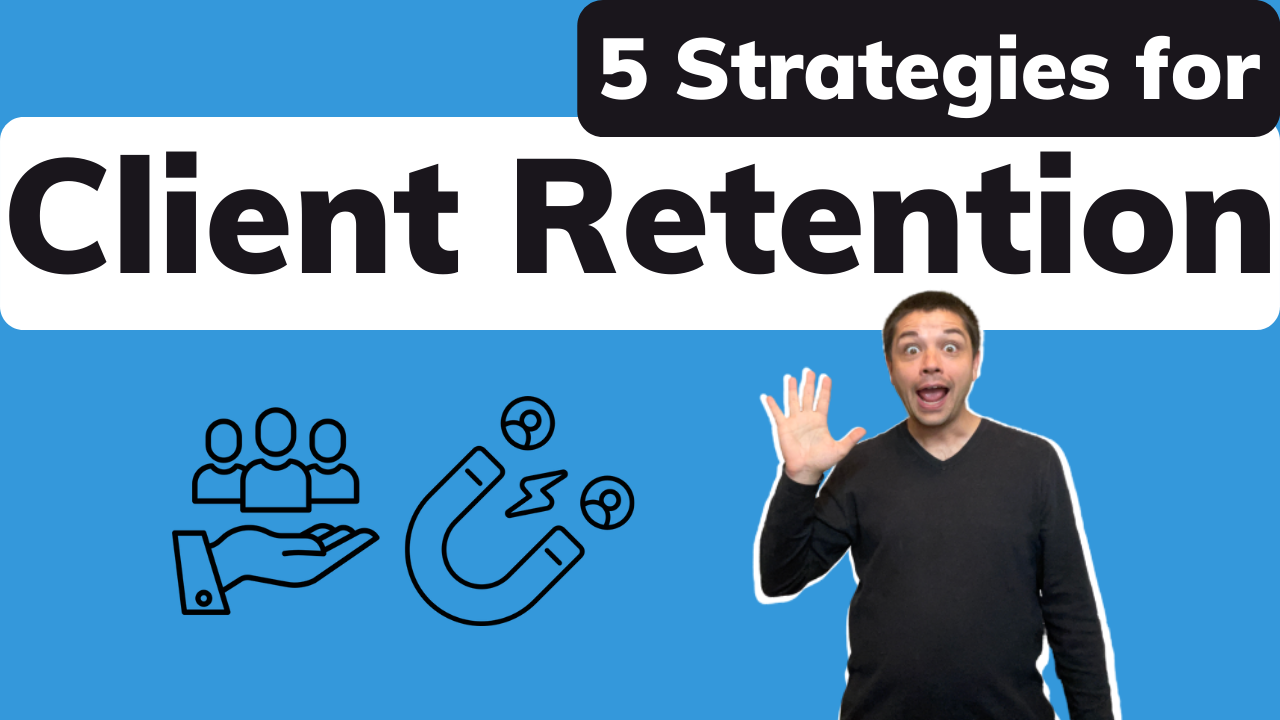5 Ways to Retain Clients | Increase MRR (monthly recurring revenue) | Keep Students Longer

As an independent teacher or entrepreneur of any sort it is extremely important to be able to find students, customers, or clients. The only thing more important than finding them - keeping them. In this short article we will discuss five strategies that you can immediately implement that will increase your client retention.
And if you need my help with anything, book a consultation here.
Client retention, not student retention
It's also important to start with the correct mindset from the outset. And that means accepting the following fact: You are a small business. It doesn't matter how many years of experience you have as a teacher. It doesn't matter which degrees or certificates you have either. Those things are only important if you use them in your self-promotion.
You need to think like the small business that you are and not limit yourself to operating how everyone expects a teacher to operate. There is a time and place to deliver your teaching services, but that should be a clearly separated experience from how your business works with its clients. And both of those should be completely separate experiences from how your clients find out about the services you offer.
Yes, all of the thing we teach are important. Our professional experience is important. But it's important in a certain context. That context is the classroom. Outside of the classroom we have to develop business and marketing skills because it's not the classroom and it doesn't require our teacher skills. We have to retool.
#5 Increase retention by offering subscription payment options
One of the easiest and fastest ways to keep students longer is by automatically withdrawing their payment each month as part of a subscription. Payment services like Stripe and PayPal let you set up subscription offers that automatically charge customer's cards every week, month, or year. This removes the awkward reminders you might otherwise send to collect payment each month, not to mention hours of correspondence and follow up.
The main drawback to offering automatic subscription payment options is that some customers don't understand this technology and get upset that you've charged them. Although it seems rather intuitive and there is a clear option to cancel or unsubscribe, some customers will contact you to complain that you've charged them or to ask for a refund. How you deal with those complaints is up to you, but you should definitely include a well-written refund policy in the terms and conditions of your website.
The biggest advantage of subscription payment options is the predictability of your cash flow. You can count your monthly subscribers, your MRR (monthly recurring revenue), your churn rate (how many subscriptions you've lost), and you can project with some certainty what the next month(s) will bring.
It's also important to remember that payment methods define niches. Some people prefer paying by card and some prefer paying with cash. If your niche pays you in cash now and you try to switch them to automatic payments by card, it is likely to be a catastrophe. Offering subscription payment options is best suited for customers who already make online purchases. If your current customers pay cash, don't fret. You'll have to target a different group of people (those who make online purchases) if you want to offer subscription payment options.
#4 Increase retention with longer or bigger offers
Another way to keep clients longer is by changing what you sell them. If you sell 50 units of your product (for example: 50 lessons), then you will collect more money upfront than if you sell 10 units at a time. Plus, you'll do five times less work because you only had to make one sale. By selling more upfront you retain clients longer in your product delivery cycle.
And let's be honest, it takes a long time to get really big results. The longer we work with our clients, the more likely they are to experience significant results that turn them into our raving fan. If they've had a great experience with us, they are more likely to make additional purchases and to speak about us positively to others.
However, it's important not to get trapped in the product delivery part of our business because we will quickly run out of time to do growth activities like marketing and advertising. There's a delicate balance that we need to manage between providing out-of-this-world results and above-average customer service and sales, promotions, email marketing and creating content or building our website. If we don't market ourselves, we won't be able to reliably get new clients and our business won't grow.
#3 Increase retention with town hall meetings
If you want your clients to stay longer, you need to get them involved in the development of your business by sharing your mission with them and showing them the role they play in the success of your mission. A town hall meeting, when you invite your clients to a group meeting to discuss what they like and don't like about your product and for you to get suggestions from them, is a great way to do this. The quicker you implement their suggested changes, the happier they will be.
Psychologically, when we listen to someone's suggestion, then we implement it and use it, and then we give them credit by telling them that we've used their idea, this causes the person to feel a sense of ownership over the idea and its implementation. This means our client feels that our product is part of their identity - they identify with it on a personal level.
This is one of the highest levels of service to your clients. They share their sincere thoughts and what would be ideal or convenient for them and you share your honest thoughts for how or why you can or can't. A town hall meeting doesn't mean they tell you what to do and you blindly follow. It means you show them that you have listened to their suggestions; you show them that you care about their wishes and feelings; and you've communicated to them the challenges or barriers that you are facing that might make it difficult for you to bring their suggestions to fruition. It's an open line of communication once a month or less often.
#2 Increase retention by offering bonuses
It might sound too easy to offer your clients small bonuses every so often in order to encourage them to stay with you longer, but it's quite effective. Let's say you want to increase how long the average client stays on a monthly subscription plan. You could give them a new bonus every ten days to remind them that you will continue to provide value next month (and that they should keep paying because they will get more).
And the definition of bonus is flexible. It could be a worksheet, download, or PDF. But it could also be a book, a t-shirt, a planner, a calendar, or something else. It could even be something as easy as a video or audio file.
But the bonus itself isn't enough. You need to communicate to your clients how your bonuses play into the overall product they've subscribed to. You need to tell them that you give better and better bonuses to clients who stay longer. You need to announce bonuses in a way that both piques their interest and communicate gratitude. There is not such thing as thanking your client too many times for helping you achieve your mission.
#1 Increase retention by underpromising and overdelivering
My top piece of advice for anyone who wants to retain their clients longer is to underpromise and overdeliver. That means, promise less than what you will actually give them. There are lots of ways that this can be accomplished because most people are accustomed to only getting what they've paid for and nothing else. By adding small benefits or pluses, we show our clients that we are invested in them reaching their goals and we want to exceed their expectations. Customers tend to stay with businesses that give them extra benefits.
Managing the expectations of our clients is paramount. Before they make a purchase they want to know what to expect. If they are satisfied enough with what you've promised, they will pay. But collecting payment isn't the end of the story. In fact, it's just the beginning because now is when they will compare their expectations to reality. You are never going to meet all of every client's expectations, but you can "cheat" by dropping in additional value so often that they are satisfied with the overall experience, even if they aren't fully satisfied with the product itself.
In other words, you should go above and beyond to make sure your clients have a great experience, even if that means giving them more than what they've paid for. But we have to be careful not to sacrifice marketing and growth for product delivery and stagnation.


